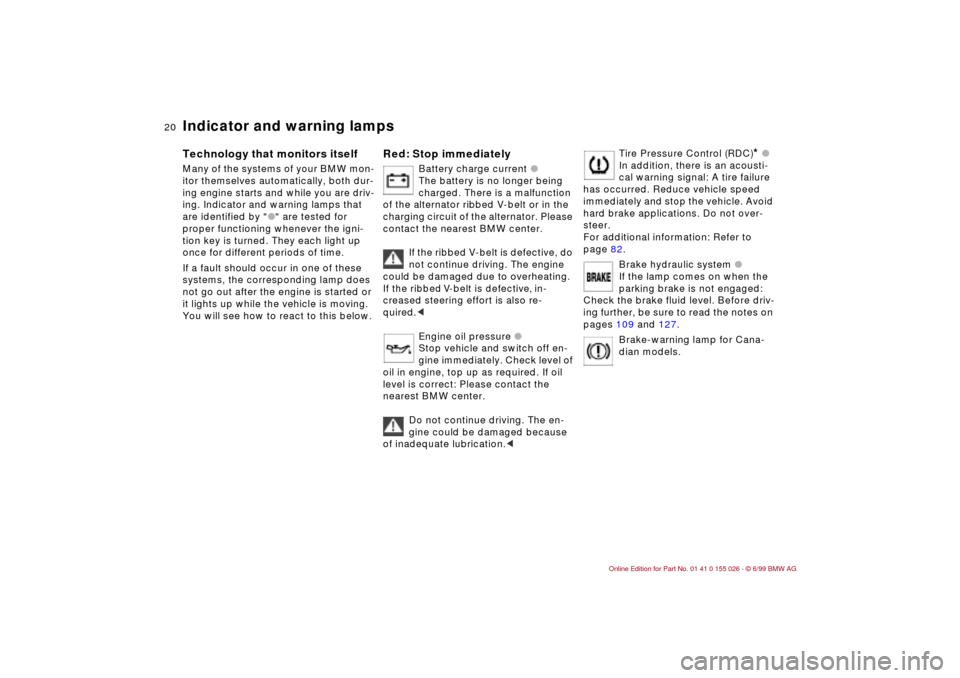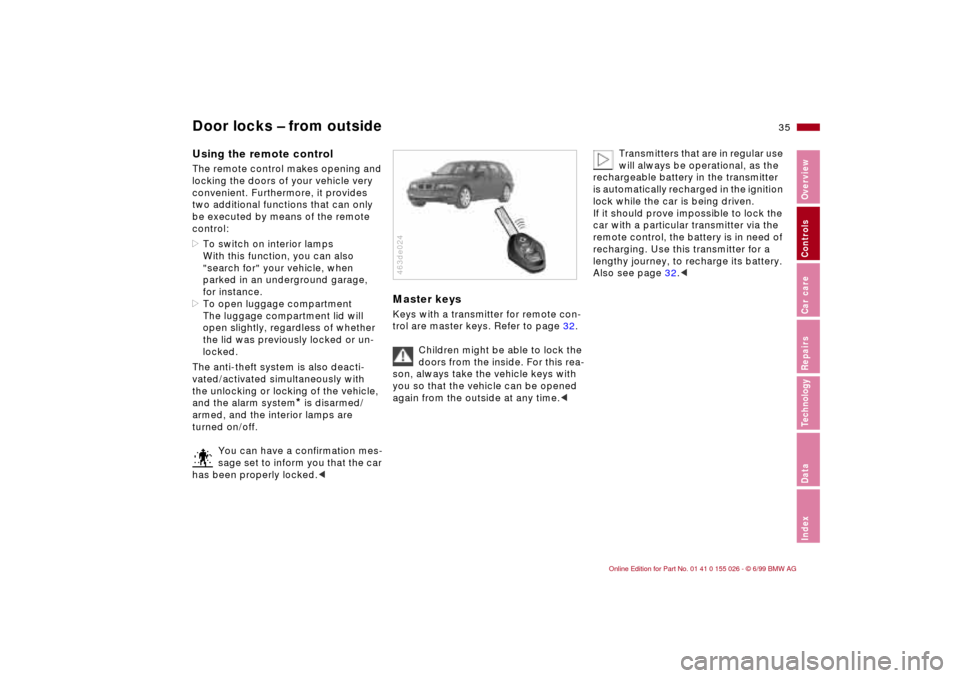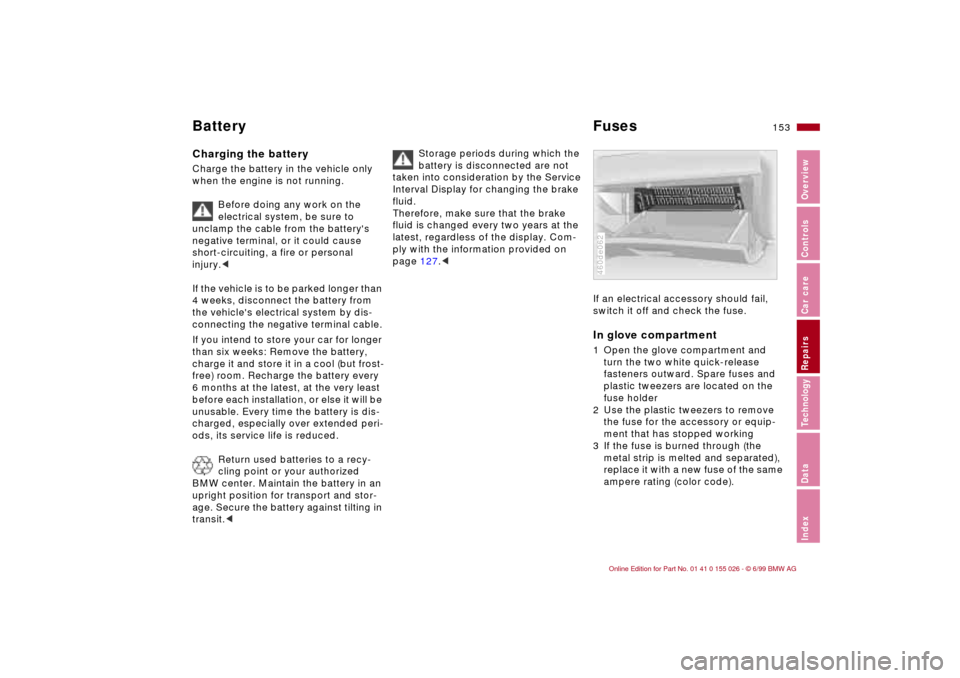Page 22 of 189

20n
Indicator and warning lamps
Technology that monitors itself
Many of the systems of your BMW mon-
itor themselves automatically, both dur-
ing engine starts and while you are driv-
ing. Indicator and warning lamps that
are identified by "
l
" are tested for
proper functioning whenever the igni-
tion key is turned. They each light up
once for different periods of time.
If a fault should occur in one of these
systems, the corresponding lamp does
not go out after the engine is started or
it lights up while the vehicle is moving.
You will see how to react to this below.
Red: Stop immediately
Battery charge current
l
The battery is no longer being
charged. There is a malfunction
of the alternator ribbed V-belt or in the
charging circuit of the alternator. Please
contact the nearest BMW center.
If the ribbed V-belt is defective, do
not continue driving. The engine
could be damaged due to overheating.
If the ribbed V-belt is defective, in-
creased steering effort is also re-
quired.
<
Engine oil pressure
l
Stop vehicle and switch off en-
gine immediately. Check level of
oil in engine, top up as required. If oil
level is correct: Please contact the
nearest BMW center.
Do not continue driving. The en-
gine could be damaged because
of inadequate lubrication.
<
Tire Pressure Control (RDC)
* l
In addition, there is an acousti-
cal warning signal: A tire failure
has occurred. Reduce vehicle speed
immediately and stop the vehicle. Avoid
hard brake applications. Do not over-
steer.
For additional information: Refer to
page 82.
Brake hydraulic system l
If the lamp comes on when the
parking brake is not engaged:
Check the brake fluid level. Before driv-
ing further, be sure to read the notes on
pages 109 and 127.
Brake-warning lamp for Cana-
dian models.
Page 37 of 189

35n
RepairsIndexOverview Controls Car care Technology Data
Door locks – from outsideUsing the remote control The remote control makes opening and
locking the doors of your vehicle very
convenient. Furthermore, it provides
two additional functions that can only
be executed by means of the remote
control:
>To switch on interior lamps
With this function, you can also
"search for" your vehicle, when
parked in an underground garage,
for instance.
>To open luggage compartment
The luggage compartment lid will
open slightly, regardless of whether
the lid was previously locked or un-
locked.
The anti-theft system is also deacti-
vated/activated simultaneously with
the unlocking or locking of the vehicle,
and the alarm system
* is disarmed/
armed, and the interior lamps are
turned on/off.
You can have a confirmation mes-
sage set to inform you that the car
has been properly locked.<
Master keysKeys with a transmitter for remote con-
trol are master keys. Refer to page 32.
Children might be able to lock the
doors from the inside. For this rea-
son, always take the vehicle keys with
you so that the vehicle can be opened
again from the outside at any time.<463de024
Transmitters that are in regular use
will always be operational, as the
rechargeable battery in the transmitter
is automatically recharged in the ignition
lock while the car is being driven.
If it should prove impossible to lock the
car with a particular transmitter via the
remote control, the battery is in need of
recharging. Use this transmitter for a
lengthy journey, to recharge its battery.
Also see page 32.<
Page 155 of 189

153n
RepairsIndexOverview Controls Car care Technology Data
Battery FusesCharging the battery Charge the battery in the vehicle only
when the engine is not running.
Before doing any work on the
electrical system, be sure to
unclamp the cable from the battery's
negative terminal, or it could cause
short-circuiting, a fire or personal
injury.<
If the vehicle is to be parked longer than
4 weeks, disconnect the battery from
the vehicle's electrical system by dis-
connecting the negative terminal cable.
If you intend to store your car for longer
than six weeks: Remove the battery,
charge it and store it in a cool (but frost-
free) room. Recharge the battery every
6 months at the latest, at the very least
before each installation, or else it will be
unusable. Every time the battery is dis-
charged, especially over extended peri-
ods, its service life is reduced.
Return used batteries to a recy-
cling point or your authorized
BMW center. Maintain the battery in an
upright position for transport and stor-
age. Secure the battery against tilting in
transit.<
Storage periods during which the
battery is disconnected are not
taken into consideration by the Service
Interval Display for changing the brake
fluid.
Therefore, make sure that the brake
fluid is changed every two years at the
latest, regardless of the display. Com-
ply with the information provided on
page 127.<
If an electrical accessory should fail,
switch it off and check the fuse. In glove compartment1 Open the glove compartment and
turn the two white quick-release
fasteners outward. Spare fuses and
plastic tweezers are located on the
fuse holder
2 Use the plastic tweezers to remove
the fuse for the accessory or equip-
ment that has stopped working
3 If the fuse is burned through (the
metal strip is melted and separated),
replace it with a new fuse of the same
ampere rating (color code).460de062
Page 186 of 189

Owner service procedures from A to ZAActivated charcoal filter,
changing 154
Add brake fluid 127
Add coolant 126
Add engine coolant 126
Adjust washer nozzles 122
Avoiding a false alarm 43
Avoiding unwanted
alarm 43BBackup lamps
bulb replacement 143
Battery
add distilled water 152
charging 153
Brake lamps
bulb replacement 143
Brakes, brake faults 109CChanging tires 148
Check air pressure 27
Check Control 77
Check engine oil level 123
Check oil level 123
DDefrost windshields 91
Difficult steering 112
Doors
emergency actuation 34EElectrical accessories,
failure 153
Electrical failure
fuel filler door 155
Electrical fault
sliding/tilt sunroof 155
Emergency actuation
doors 34
Emergency closing
sliding/tilt sunroof 155
Emergency release
fuel filler door 155
Engine oil
add 123
quality 124
specifications 124
viscosity 124FFailure messages 77
Fault displays 77
First aid 25
First aid kit 25Fittings, towing 157
Flat tire 148
Fog lamps
bulb replacement 143
Footwell lamps
bulb replacement 146
Fuel filler door
manual release after
electrical fault 155
Fuses, replacing 153
GGlove compartment lamp
bulb replacement 146HHazard warning flashers 25
Hazard warning triangle 25
Headlamp cover, care 141
High beams, bulb
replacement 141IIndicator lamps 20
Inflated pressure 27
Interior lamps
bulb replacement 145JJack 148
LLicense plate light
bulb replacement 145
Low beams, bulb
replacement 141
Luggage compartment
emergency release 39
Luggage compartment
lamps
bulb replacement 146
Luggage compartment lid
emergency release 39MMaintenance 129
Malfunction displays 77
Microfilter, changing 154NNew transmitter, radio
remote control 147OOil
quality 124
specifications 124
viscosity 124
Onboard tool kit 140